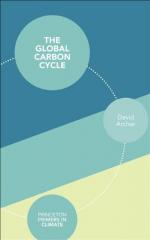|
This section contains 1,331 words (approx. 5 pages at 300 words per page) |

|
The series of chemical, physical, geological, and biological changes by which carbon moves through the Earth's air, land, water, and living organisms is called the carbon cycle.
Carbon makes up no more than 0.27% of the mass of all elements in the universe and only 0.0018% by weight of the elements in the Earth's crust. Carbon occurs in many different chemical combinations, including calcium carbonate (CaCO3), carbon dioxide (CO2), methane (CH4), and a huge diversity of organic compounds (including hydrocarbons and biochemicals). In contrast to carbon's relative scarcity in the environment, it makes up 19.4% by weight of the human body. Along with hydrogen, carbon is the only element to appear in every organic molecule in every living organism on Earth.
The most abundant mineral forms of carbon in the rocks and soil of the Earth's crust are limestone (CaCO3) and dolomite [CaMg(CO3)2]. These mostly occur in sedimentary...
|
This section contains 1,331 words (approx. 5 pages at 300 words per page) |

|


